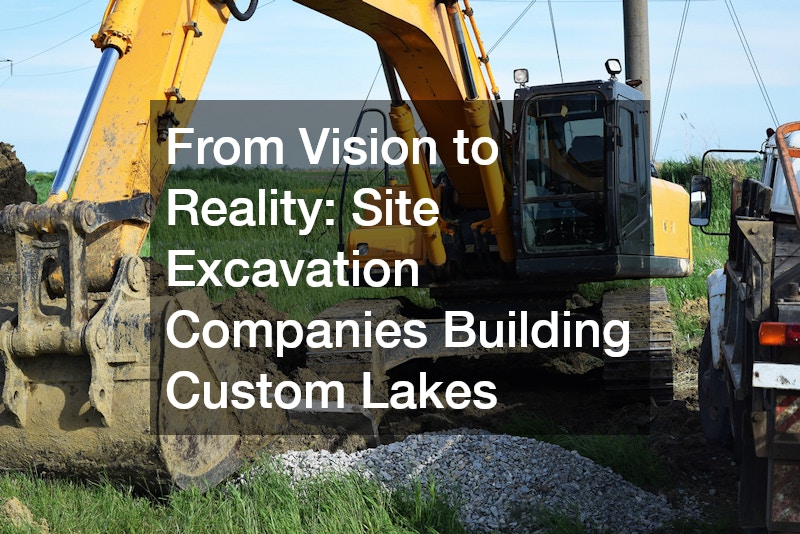This article explores the intricate process of building custom lakes, highlighting the essential role of a site excavation company in transforming visions into reality. Constructing a lake involves much more than just digging a hole—it requires careful planning, technical expertise, and collaboration between property owners and professionals. From assessing the land to shaping the final design, site excavation companies manage every detail to ensure the project is both beautiful and functional.
We will address common questions and concerns regarding the excavation process, design considerations, costs, and maintenance of custom-made lakes to help you understand what goes into bringing your dream water feature to life.
What Is the Process of Excavating a Custom Lake?
Excavating a site typically begins with a detailed survey and assessment of the land. A good site excavation company performs topographical studies to evaluate soil composition, drainage patterns, and environmental factors that influence where and how the lake can be constructed. This initial phase is critical to identify any potential challenges and to ensure the project complies with local regulations.
The planning phase follows, involving the creation of detailed blueprints that specify the size, shape, and depth of the lake. Collaboration between the property owner and excavation professionals is key here, as the plans need to reflect both practical requirements and aesthetic goals. At this stage, obtaining the necessary permits and ensuring legal compliance is essential before any physical work begins.
Once all plans are finalized and permits secured, the excavation itself starts. Heavy machinery like excavators and bulldozers are used to remove soil and rocks, carefully sculpting the landscape to create the desired lake formation. The duration of this phase can vary widely depending on the complexity and scale of the project, ranging from a few weeks for smaller ponds to several months for large lakes.
What Factors Should Be Considered When Designing a Custom Lake?
A look into the key design elements that influence the aesthetics and functionality of a custom lake. The location of the lake plays a vital role in design decisions, including sun exposure, existing vegetation, and proximity to other structures. These factors not only affect appearance but can also impact ecological balance.
Water depth, shoreline shape, and access points for recreational activities are other critical design aspects to consider. Depth affects both the ecosystem and aesthetics; deeper areas may support fish habitats while shallow banks provide excellent shoreline for planting.
Incorporating features like islands, fountains, or beaches enhances the visual appeal and functional use of the lake. Additionally, considering the incorporation of native plants and landscaping elements can further enrich the lakeside experience, making it a natural extension of the surrounding environment.
How Much Does It Cost to Build a Custom Lake?
An overview of the factors that affect the cost of building a custom lake and budgeting considerations. Costs for such projects can vary significantly, influenced by location, size, and design complexity. Other factors like geological conditions can also lead to higher excavation costs if additional work is required.
Of course, not all expenses are directly related to excavation. Additional costs might include landscaping, water features, and ongoing maintenance needs. Engaging specialists for environmental assessments can also add to the overall budget but ensure compliance with regulations.
When planning financially, clients should consider a buffer for unexpected costs. Engaging with site excavation companies can help provide accurate quotes and realistic expectations, allowing clients to understand the financial implications of their envisioned project.
What Maintenance Is Required After a Custom Lake Is Built?
Insights into ongoing maintenance tasks that ensure the health and longevity of a custom lake. Regular inspections and maintenance tasks are imperative to sustain water quality and ecosystem health. These may include monitoring vegetation growth, water levels, and ensuring the proper aeration of the lake.
Annual or biannual dredging may be necessary to manage sediment buildup, which can undermine the aesthetic and ecological balance. Managing runoff water through proper landscaping and filtration systems also plays a crucial role in preventing pollution.
In addition to physical maintenance, engaging with a biologist or lake management professional can help develop a biodiversity strategy. This may involve adding fish species or planting aquatic plants that support wildlife and enhance the overall ecological health of the lake.
Building a custom lake is a complex yet rewarding endeavor that requires careful planning and execution. By understanding the process, design considerations, costs, and maintenance, potential clients can better navigate their journey from vision to reality with the help of site excavation companies.

